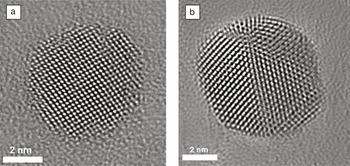The plasmon resonances of metallic nanoparticles can be exploited in many applications ranging from photovoltaics to the destruction of cancer cells, molecular detection, and solar energy harvesting. While the behavior of larger nanoparticles has been well-studied, research into the behavior of quantum-sized metallic nanoparticles (<10 nm in diameter) has been hindered by weak signals that are considerably broadened with decreasing nanoparticle size.
As reported in the March 22 issue of Nature (DOI: 10.1038/nature10904; p. 421), J. Scholl, A.L. Koh, and J. Dionne of Stanford University have adopted a unique approach to investigate the localized surface plasmon resonance (LSPR) properties of nanoparticles in the quantum-size regime. The researchers examined the behavior of individual silver nanospheres with diameters ranging from 2 nm to 20 nm using aberration-corrected transmission electron microscopy (TEM) imaging in conjunction with monochromated scanning TEM electron energy-loss spectroscopy (STEM-EELS). The silver nanospheres were synthesized without ligands to ensure that ligand damping effects did not influence the experiments.

Aberration-corrected transmission electron micrographs of silver nanoparticles synthesized free of stabilizing ligands: (a) 6 nm diameter, (b) 7 nm diameter. Reproduced by permission from Nature 483 (2012), DOI: 10.1038/nature10904; p. 421. ©2012 Macmillan Publishers, Ltd.
LSPR spectra were collected by focusing the STEM’s electron beam at the edge of each sphere. The LSPR blue-shifted from 3.3 eV to 3.8 eV as the sphere diameter was decreased from 20 nm to 1.7 nm. This compares with a shift of only +0.03 eV predicted by classical Mie Theory over the same size range. The bulk plasmon resonance can also be detected with the STEM-EELS technique and exhibited a blueshift as the particle size decreased, although with a smaller magnitude than the surface plasmon resonance spectra.
To explain the observed behavior, the researchers developed an analytical model rooted in quantum theory that accounts for changes in the metal’s electric permittivity. According to the theory, the collective plasmon oscillations became increasingly sensitive to the quantum nature of individual electron transitions as particle dimensions diminished. Despite a number of simplifying assumptions, such as infinite potential barriers, the energies of the model’s LSPRs closely matched the EELS observations. This initial theory can be applied to other metals and geometries by making modifications to the key parameters in the dielectric function.
The research team now anticipates that researchers may be able to exploit the behavior of quantum-sized nanoparticles for a variety of applications. Because of their high-surface-area-to-volume ratios, these nanoparticles are ideal candidates for sensor and catalysis applications, particularly for events that involve interactions with very few photons or transferred electrons. Quantum-sized nanoparticles may also be of value in biological systems since they should be able to maneuver through cellular environments with greater ease than their larger counterparts.

